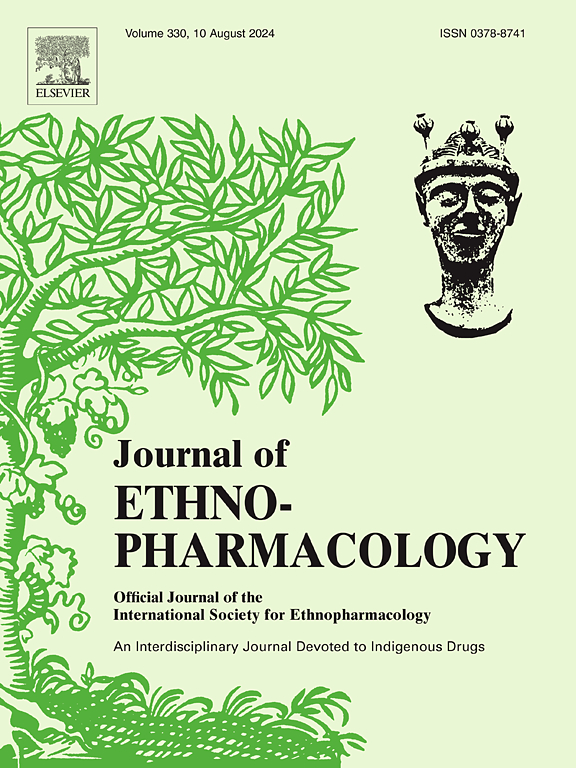Solidago decurrens Lour. controls LPS-induced acute lung injury by reducing inflammatory responses and modulating the TLR4/NF-κB/NLRP3 signaling pathway
IF 4.8
2区 医学
Q1 CHEMISTRY, MEDICINAL
引用次数: 0
Abstract
Ethnopharmacological relevance
Acute lung injury (ALI) is a lethal respiratory disease associated with severe inflammatory responses. Solidago decurrens Lour. (SdL) has been shown to exhibit anti-inflammatory and antibacterial activities. However, the pharmacological effects of SdL on ALI and the underlying mechanisms remain unexplored.
Aim of the study
In this study, we investigated the ability of SdL to control lipopolysaccharide (LPS)-induced inflammation in vitro and in vivo. We took an integrated approach of using network pharmacology with molecular and cellular techniques to understand the molecular mechanisms for SdL's anti-inflammatory activity.
Methods
UHPLC-QE-Orbitrap-MS was employed to identify bioactive compounds in SdL. Using network pharmacology approaches, we investigated SdL's potential targets and pathways against ALI. The active components and potential targets of SdL were obtained from the Traditional Chinese Medicine Systems Pharmacology (TCMSP) database, and target genes of ALI were obtained from Online Mendelian Inheritance in Man (OMIM), GeneCards, Therapeutic Target Database (TTD), DisGeNET database. The common target genes were collected using Venny. The SdL-compounds-common targets-ALI network was constructed using Cytoscape 3.9.1. The protein-protein interaction (PPI) network of SdL-ALI targets was established, with core targets identified and visualized through Cytoscape 3.9.1. The DAVID database was used for GO and KEGG enrichment analysis. Subsequently, we used the MTT assay, qPCR technique, ELISA, and immunoblotting to determine cell viability, gene expression, cytokines, and specific protein modulators, respectively. We used H&E staining to detect pathological changes in the lung tissues.
Results
A total of 19 compounds in SdL were screened through the UHPLC-QE-Orbitrap-MS and TCMSP databases, and a total of 209 potential gene targets were obtained from these 19 compounds. ALI obtained a total of 1,932 gene targets from OMIM, GeneCards, TTD, DisGeNET database. A total of 140 common gene targets of SdL and ALI were obtained through Venn diagrams. The results of the SdL-compounds-common targets-ALI network indicate that quercetin and kaempferol may be the main compounds for SdL in the treatment of ALI. The PPI results indicated that TNF, IL6 and IL1B played important roles in the regulation of ALI by SdL. The results of GO and KEGG enrichment analysis indicated TNF, Toll-like receptors and NF-kappa B pathways, suggesting the mechanism by which SdL controls ALI through its anti-inflammatory function. Subsequently, our results indicated that SdL treatments reduced COX-2 and iNOS, as well as suppressed the LPS-induced inflammatory cytokines (IL-1β and IL-6) in RAW 264.7 macrophage and lung tissues of mice. SdL treatment was able to suppress the LPS-induced NLRP3 inflammasome activation and the TLR4/NF-κB signaling pathway. Pretreatment of animals with SdL alleviated the LPS-induced pathological changes in the lung tissues.
Conclusion
Considering these results together, we suggested that SdL was capable of mitigating inflammation and LPS-induced ALI by modulating the TLR4/NF-κB/NLRP3 pathway. SdL should be seriously considered in clinical studies to control ALI.

Solidago decurlour。通过降低炎症反应和调节TLR4/NF-κB/NLRP3信号通路控制lps诱导的急性肺损伤
民族药理学相关性:急性肺损伤(ALI)是一种与严重炎症反应相关的致命呼吸系统疾病。Solidago decurlour。(SdL)已被证明具有抗炎和抗菌活性。然而,SdL对ALI的药理作用及其潜在机制仍未被探索。研究目的:在本研究中,我们在体外和体内研究SdL对脂多糖(LPS)诱导的炎症的控制能力。我们采用网络药理学与分子和细胞技术相结合的方法来了解SdL抗炎活性的分子机制。方法:采用UHPLC-QE-Orbitrap-MS法对SdL中的生物活性成分进行鉴定。利用网络药理学方法,我们研究了SdL对抗ALI的潜在靶点和途径。SdL的有效成分和潜在靶点来自中药系统药理学(TCMSP)数据库,ALI的靶基因来自人类孟德尔在线遗传(OMIM)、GeneCards、治疗靶点数据库(TTD)、DisGeNET数据库。用Venny法收集共有靶基因。利用Cytoscape 3.9.1构建SdL-compounds-common targets-ALI网络。建立SdL-ALI靶点的蛋白-蛋白相互作用(PPI)网络,通过Cytoscape 3.9.1对核心靶点进行鉴定和可视化。DAVID数据库用于GO和KEGG富集分析。随后,我们分别使用MTT测定法、qPCR技术、ELISA和免疫印迹法测定细胞活力、基因表达、细胞因子和特异性蛋白调节剂。我们用H&E染色检测肺组织的病理变化。结果:通过UHPLC-QE-Orbitrap-MS和TCMSP数据库共筛选出SdL中的19个化合物,从中共获得209个潜在基因靶点。ALI从OMIM、GeneCards、TTD、DisGeNET数据库共获得1932个基因靶点。通过维恩图得到SdL和ALI共有的140个基因靶点。SdL化合物-共同靶点-ALI网络的结果表明,槲皮素和山奈酚可能是SdL治疗ALI的主要化合物。PPI结果提示TNF、IL6和IL1B在SdL对ALI的调节中发挥重要作用。GO和KEGG富集分析结果提示TNF、toll样受体和NF-kappa B通路,提示SdL通过其抗炎功能控制ALI的机制。随后,我们的研究结果表明,SdL处理降低了小鼠RAW 264.7巨噬细胞和肺组织中COX-2和iNOS,并抑制了lps诱导的炎症细胞因子(IL-1β和IL-6)。SdL治疗能够抑制lps诱导的NLRP3炎性体激活和TLR4/NF-κB信号通路。SdL预处理动物可减轻lps诱导的肺组织病理改变。结论:综合上述结果,我们认为SdL可通过调节TLR4/NF-κB/NLRP3通路减轻炎症和lps诱导的ALI。在临床研究中应认真考虑使用SdL来控制ALI。
本文章由计算机程序翻译,如有差异,请以英文原文为准。
求助全文
约1分钟内获得全文
求助全文
来源期刊

Journal of ethnopharmacology
医学-全科医学与补充医学
CiteScore
10.30
自引率
5.60%
发文量
967
审稿时长
77 days
期刊介绍:
The Journal of Ethnopharmacology is dedicated to the exchange of information and understandings about people''s use of plants, fungi, animals, microorganisms and minerals and their biological and pharmacological effects based on the principles established through international conventions. Early people confronted with illness and disease, discovered a wealth of useful therapeutic agents in the plant and animal kingdoms. The empirical knowledge of these medicinal substances and their toxic potential was passed on by oral tradition and sometimes recorded in herbals and other texts on materia medica. Many valuable drugs of today (e.g., atropine, ephedrine, tubocurarine, digoxin, reserpine) came into use through the study of indigenous remedies. Chemists continue to use plant-derived drugs (e.g., morphine, taxol, physostigmine, quinidine, emetine) as prototypes in their attempts to develop more effective and less toxic medicinals.
 求助内容:
求助内容: 应助结果提醒方式:
应助结果提醒方式:


